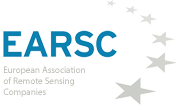This week I am in Pretoria or Tshwane, as it is now called, for the ISRSE 2017 conference. This is the 37th ISRSE which is an impressively long record. In addition to some really interesting papers concerning African space policy, space agencies activities and on climate change impact, two particular points stand out.
Firstly is the ambition coming from the whole continent and being led/orchestrated by the African Union Commission. An African Space Policy has been published in which EO features prominently and where GMES and Africa is a main element. Secondly was the B2B meeting which we organised to enable networking between European and African companies. I’ll start with the latter.
This was the second such event we have organised with the first one being during the AARSE conference last October in Kampala. In each case we are grateful for local support without which such an initiative would not be possible. We had 5 companies from Europe and 5 from Africa which participated. Very short introductory presentations from the European companies was followed by a “speed-dating” session providing each company to introduce itself to the others. Given the difficulty I had separating some of the company pairs the exchanges were quite productive. Participants agreed at the end that the formula was a good one and we shall seek to recreate similar opportunities in the future. There is strong support for further exchanges with African companies and we'll seek opportunities to do so.
At the end we managed to get Tidiane Ouattara to talk about GMES and Africa. The call is to be launched next week and Tidiane explained how the private sector will be involved with 20% of the funding needing to be spent with service providers. Partnerships between African and European companies are almost mandatory with no set conditions excepting that there must be a partnership agreement in place showing how the African business will benefit from the arrangement.
We’ll publish more information for members as it becomes available. I shall be presenting on Thursday and part of the plenary panel on Friday looking at how big data and other trends affecting commercial EO services. I'll be talking about MAEOS and eoMALL. The meeting concludes with a session on the GEO WorkProgramme taking place on Friday and Saturday.
As a committed member of the EO Community, at EARSC we are convinced that the inherent value in satellite data is very high. Indeed, the European policy makers would not have invested €7b in Copernicus if they did not think so also! But is this really true?
Readers may be familiar with the 3 cases which we studied and published last year which showed that this conviction is true! We took a new approach to analysing the question and came up with some interesting answers as well as defining a new methodology. Now I am happy to say we are starting a second round of cases; if you have any suggestions we would be pleased to hear from you.
The first case studied the value of SAR imagery as an aid to “Winter Navigation in the Baltic”. The icebreakers use Sentinel 1 imagery directly to help plan their course as they lead ships through the ice to their destination port. The time saved, the greater certainty of goods arriving or leaving factories and shops all help the local community. By our calculations, the benefit to Finland and Sweden is between €24m and €116m each year!
The second case studied the value for “Forestry in Sweden”. This found that maps produced using Sentinel 2 imagery help the local owners of parcels of forest land, improve the cultivation of timber. Better quality and quantity of timber is increasing the value to the Swedish economy and the Sentinel data is contributing between €16m and €21m each year.
Finally, the third case looked at the use of ground deformation mapping as an aid to improved “Infrastructure Monitoring in the Netherlands”. Knowing where the ground has moved helps the local pipeline companies distributing gas and water to act before critical damage occurs. This helps the companies develop value of between €15m and €18m per annum.
We are pleased that EARSC has now been awarded a further contract by ESA to analyse more cases. We already have a good list of potential ones but we should love to have more! Each case must make some use of Sentinel data and be operational so that there is a regular use of the products and services.
If you can propose cases that are selected for analysis then a prize awaits!
